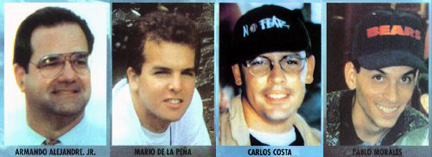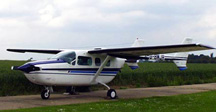|
Home
|
Los Hermanos, RIP Murder in the sky On February 24, 1996, fidel castro murdered three U.S. citizens and a fourth man, who was a legal U.S. resident. (Photo courtesy Brothers To The Rescue) Armando Alejandre, Mario de la Pina, Carlos Costa and Pablo Morales were flying a humanitarian mission for Brothers To The Rescue (Hermanos Al Rescate) that day. The men were flying two small, civilian planes when Cuban MiGs, under the direct orders of fidel casto blew them out of the sky. A third plane, piloted by Jose Basulto, escaped. I have to rely on memory for the events leading up to their deaths. The World Wide Web was still new in the early 90s, and a lot of the background doesn't seem to be online. But here's what had happened, to the best of my recollection. The fall of the Soviet Union in 1991 deprived fidel of economic support. Cuba was undergoing such an financial crisis, horses were once again in the streets of Havana and oxen were working the farms in place of tractors. By 1994 there were food riots in Havana. I was working for a Fox television station at the time (this was before the Fox News Channel existed) and Fox fed a little video of the ruckus. Cubans began again to make concentrated efforts to escape fidel's gulag. On July 13, an old tugboat "13 de Marzo" carried 72 people as they tried to escape Cuba. As later found by The Inter-American Commission on Human Rights, four Cuban patrol boats attacked the tug seven miles off the coast. The Cuban boats first fired water cannon, then rammed the boat and sank it. 41-people died - many of them children 31-people survived to write their stories of that awful day.
The three Polargo tug boats surrounded our ship and began using the high pressure water hoses once again forcing "13 de Marzo" to get away from the coast. They crashed "13 de Marzo" intentionally again and over again, trying to overturn us. But "13 de Marzo"'s structure was really strong. Then they decided to stand one in front and one behind us. The Polargo behind us hit "13 de Marzo" several times until our tug boat began to sink. When they saw our ship was sinking, the Polargo behind us rode 13 de Marzo's stern. Fifty percent of "13 de Marzo" was already under water at that time. Through the late summer and fall, the turmoil on the island continued, and people began to escape on the most fragile of rafts. The beaches of Florida, even as far north as St. Augustine, were littered with the remains. Many were simply wooden bracing holding thick pieces of Styrofoam, glued together with a black, tar-like substance, and attached to huge air-filled inner tubes that were branded Made In China. How did these people have the courage to brave the sea in those frail craft? It must show the value of freedom. The exile community was enraged over the 13 de Marzo incident. Movimiento Democricia (Democracy Movement) conducted a memorial service for the victims on the first anniversary of the massacre, July 13, 1995. The Movement wanted to call attention to the plight of the Cuban people through peaceful protest, and organized a flotilla of boats that sailed as close as they could to the site of the killings while remaining in International waters. Los Hermanos flew air cover over the flotilla. Brothers to the Rescue pilots continued to fly air missions through late 1995 and into early 1996. On February 24, 1996, the four men plus Basulto flew their three unarmed aircraft over Cuba itself, dropping leaflets. That's when fidel decided to strike. He told Dan Rather in a 1996 interview that he personally took responsibility for ordering the attack. A Cuban MiG shot them out of the sky over International waters. Brothers to the Rescue has a recording of the MiG's radio transmissions during the attack. A week later, exiles held another memorial service, this one in the air. Eighteen small civilian planes lifted into a wet, gray sky Saturday afternoon as hundreds of supporters at Opa-locka airport cheered, honked their horns, waved flags and flashed their car lights. Destination: the Florida Straits, where four Brothers to the Rescue flyers were gunned down by Cuban MiGs a week earlier. The funeral flight ended about 17 miles north of Cuba, where pilots -- from the Brothers group, Rafters Rescue Legion and the Cuban-American Pilots Association -- circled in what they call a "racetrack formation" for about half an hour. Father Francisco Santana of Ermita De La Caridad Catholic Church, flying in the lead plane piloted by Brothers founder Jose Basulto, said a eulogy while one by one, pilots and their passengers tossed flowers into the sea. As he prepared to leave office, President Clinton also gave an interview to Dan Rather. On December 18, 2000, Mr. Clinton expressed his outrage: THE PRESIDENT: Yes. They shot those Brothers To The Rescue planes down, in blatant violation of international law. We don't believe they were in Cuban territorial waters. But even if they were in Cuban territorial waters, it was illegal. Cuba is a signatory to the Chicago Convention which specifically says how you have to handle planes like that. It governs what we do when we see planes take off from South America, small planes that we know are unarmed that may have drugs on them. A lot of times we have to follow them until they go down somewhere, or do that. What they did, it was a deliberate illegal killing. fidel casto's legacy - deliberate, illegal killing. Update - A few days after the murders, a memorial service was held at the Orange Bowl. Val was there: I was there with my girlfriend at the time, a Colombian girl who despite having lived her whole life in Miami had never really delved into the Cuban psyche of its diaspora. She was there with me for me. She knew what it meant to me. I had to be there. I had to go regardless of the hurt. She'd seen me crying for days. Seen my father depressed and my mother somber. She'd seen the anger build up in me and turn into a rage, then, as quickly as it had begun, lulled into a whimpering sob. There were thousands of people there. I remember I had to fight back tears the moment we made it through the ramp and up into the stands. So many people, I thought. So many flags. You absolutely must read the whole thing. Update for 2006 is here.
|

 Brothers to the Rescue helped los balseros (the rafters) greatly in 1994. They selflessly flew missions over the Florida Straights, spotted the refugees and radioed their location to U.S. Coast Guard vessels, which, at the time, actually rescued the people and carried them to safety in the United States.
Brothers to the Rescue helped los balseros (the rafters) greatly in 1994. They selflessly flew missions over the Florida Straights, spotted the refugees and radioed their location to U.S. Coast Guard vessels, which, at the time, actually rescued the people and carried them to safety in the United States.